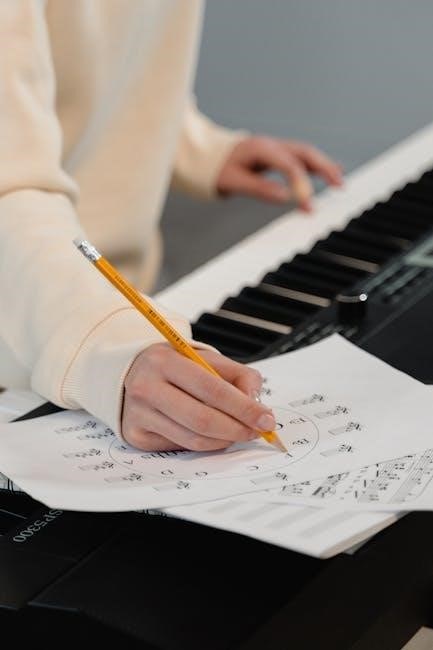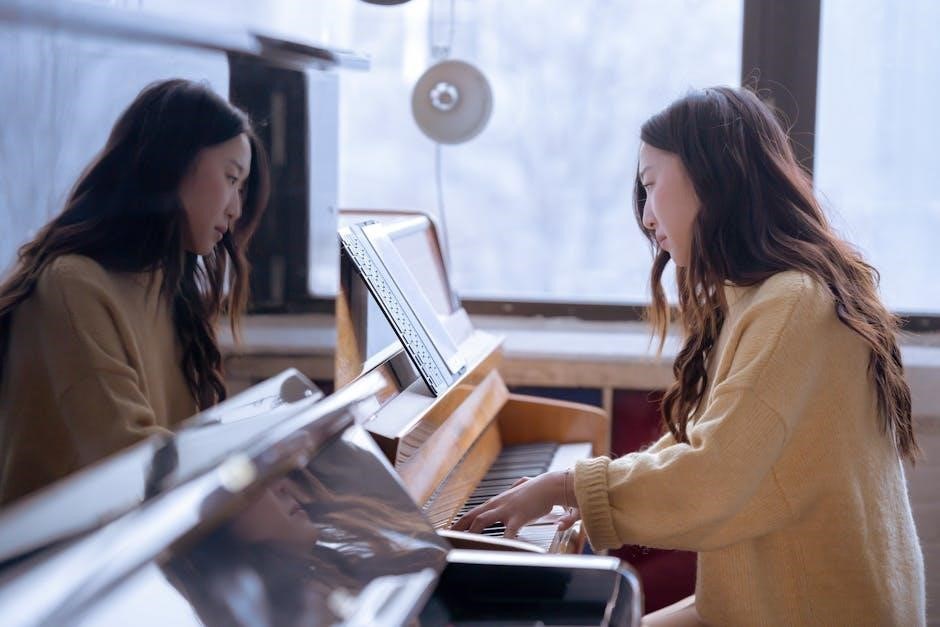Allegro, an Italian term meaning “cheerful” or “lively,” is a tempo marking indicating a fast and spirited pace, typically between 120-168 beats per minute (BPM).
1.1 Definition and Origin
Allegro, an Italian term meaning “cheerful” or “lively,” originates from the Italian word for “joyful” or “bright.” Historically, it emerged during the Baroque period as a tempo indication, guiding musicians to perform pieces with vigor and energy. Initially understood to convey a sense of joy and liveliness, its meaning has evolved to primarily denote a fast tempo. Allegro is now a standard musical term used globally, reflecting its Italian roots and the universal language of music. Its widespread adoption underscores its importance in communicating tempo and mood in compositions across genres.
1.2 Historical Context and Evolution
Allegro’s origins trace back to the Baroque era, where it initially denoted a cheerful and lively performance style. Over time, its definition shifted from describing mood to primarily indicating tempo. By the Classical period, allegro became a standard tempo marking, often used for sonata and symphony movements. Composers like Mozart and Beethoven employed it to signify energetic and dynamic pieces. The term’s evolution reflects the growing need for precise tempo notation, solidifying its role in Western music as a marker for fast, spirited performances, distinct from slower or more subdued tempos like adagio or andante.

Understanding Tempo and Allegro
Tempo refers to the speed or pace of music, guiding how fast or slow notes are played. Allegro, a specific tempo marking, indicates a brisk and lively rhythm, typically between 120-168 BPM, conveying energy and joy.
2.1 Tempo in Music: A Basic Overview
Tempo, an Italian word for “time,” refers to the speed or rate at which music is played. It is measured in beats per minute (BPM) and serves as a guide for performers to maintain a consistent pace. Tempo is crucial in conveying the emotional and structural intent of a composition. Common tempo markings include Largo (slow), Andante (moderate), and Presto (very fast). Understanding tempo is essential for interpreting musical notation accurately, as it influences rhythm, dynamics, and overall expression. Composers often use specific terms like Allegro to indicate the desired mood and energy in their works.
2.2 Allegro as a Tempo Marking
Allegro is a fundamental tempo marking in music, indicating a brisk and lively pace. Typically ranging from 120 to 168 BPM, it is faster than moderato but slower than presto. This marking conveys a sense of joy and energy, often used in the first movements of symphonies and sonatas. Composers utilize allegro to evoke a spirited and dynamic atmosphere, making it a cornerstone of classical and contemporary compositions. Its precise tempo allows for both technical brilliance and emotional expression, ensuring allegro remains a vital element in musical performance and interpretation.

Allegro vs. Other Tempo Markings
Allegro is a tempo marking faster than moderato but slower than presto, typically between 120-168 BPM, conveying lively energy and joy, distinct from other markings.
3.1 Allegro vs. Presto
Allegro and Presto are both fast tempo markings, but they differ in speed and emotional expression. Allegro, meaning “cheerful” or “lively,” typically ranges from 120 to 168 beats per minute (BPM), conveying joy and energy. Presto, meaning “quick” or “swift,” is faster, often exceeding 168 BPM, focusing solely on speed without the emotional depth of Allegro. While Allegro suggests a spirited yet controlled pace, Presto emphasizes urgency and technical precision. Composers use these markings to guide performers in interpreting the desired mood and rhythm of a piece, making them distinct in both execution and emotional impact.
3;2 Allegro vs. Allegretto
Allegro and Allegretto are both fast tempo markings but differ in speed and nuance. Allegro, meaning “cheerful” or “lively,” typically ranges from 120 to 168 beats per minute (BPM), evoking joy and energy. Allegretto, a diminutive form, is slightly slower, generally between 112-120 BPM, suggesting a more moderate and graceful pace. While Allegro emphasizes liveliness, Allegretto leans toward a lighter, almost playful character. Composers often use these markings to subtly shift the mood and rhythm of a piece, with Allegretto providing a softer contrast to Allegro’s brisk vitality.
The Role of Allegro in Musical Composition
Allegro is frequently used in sonatas and symphonies, often as the first or last movement, to establish a lively and energetic tone, shaping the overall structure and mood.
4.1 Allegro in Sonatas and Symphonies
Allegro is commonly used in the first and final movements of sonatas and symphonies to establish a lively, energetic tone. Composers like Haydn and Mozart often employed allegro to create a sense of dynamic movement and structural balance. This tempo marking not only sets the pace but also influences the emotional expression of the piece. In symphonies, allegro movements often feature intricate orchestration, showcasing the interplay between different sections. The Allegro in sonatas typically follows the exposition, development, and recapitulation, providing a framework for thematic exploration. Its use in these forms highlights its importance in classical music composition.
4.2 Allegro in Ballet and Dance Music
Allegro in ballet and dance music signifies lively and brisk movements, typically ranging from 120 to 168 beats per minute. It is often used to convey energy, joy, and vitality, guiding dancers to perform quick, intricate steps with precision. Choreographers utilize allegro to create dynamic and spirited scenes, such as grand leaps or rapid footwork. This tempo not only challenges dancers’ technical skills but also enhances the emotional expression of the performance. Allegro’s rhythmic vibrancy makes it a cornerstone in ballet, aligning movement with musical energy to captivate audiences.

Allegro and Musical Mood
Allegro, meaning “cheerful” in Italian, evokes joy and energy through its lively tempo, creating a spirited and dynamic musical atmosphere that captivates listeners with its vibrant energy.
5.1 Expressing Joy and Energy
Allegro, meaning “cheerful” or “lively,” is a tempo marking that evokes joy and energy in music. It is often used to create a spirited and vibrant atmosphere, capturing the essence of happiness and dynamism. Composers employ allegro to convey uplifting emotions, making it a cornerstone of joyful musical expressions. The brisk pace of allegro movements ensures a sense of energy, engaging listeners with its lively rhythm and tone. This tempo is particularly effective in sonatas, symphonies, and ballets, where it adds a layer of excitement and vitality to the performance.
5.2 Allegro Con Brio and Allegro Vivace
Allegro con brio and allegro vivace are expressive variations of the allegro tempo, enhancing its lively character. Allegro con brio, meaning “fast with vigor,” adds intensity and energy, often signaling a bold and spirited performance. Allegro vivace, translating to “fast and lively,” incorporates a sense of vivacity, pushing the tempo slightly faster than allegro while maintaining its joyful essence. Both terms guide musicians to infuse the music with passion and dynamism, creating a captivating auditory experience that highlights the composer’s intent for a powerful and animated execution.

Common Examples of Allegro Pieces
Beethoven’s Fifth Symphony and Mozart’s “Eine kleine Nachtmusik” are iconic examples of allegro movements, showcasing lively and energetic compositions that define the allegro tempo.
6.1 Classical Compositions Featuring Allegro
Classical music is rich with allegro movements that embody energy and joy. Beethoven’s Fifth Symphony and Mozart’s “Eine kleine Nachtmusik” are iconic examples, showcasing lively rhythms and spirited melodies. Vivaldi’s “The Four Seasons” also features allegro movements, highlighting its brisk and vibrant nature. Similarly, Haydn’s symphonies and Bach’s Brandenburg Concertos include allegro sections that reflect the tempo’s dynamic and cheerful essence. These compositions exemplify how allegro has been a cornerstone of classical music, evoking energy and joy through its fast-paced and lively characteristics.
6.2 Modern Music Incorporating Allegro
Allegro’s lively and energetic essence is evident in modern music across various genres; Pop songs like “Uptown Funk” by Mark Ronson and “Can’t Stop the Feeling!” by Justin Timberlake feature allegro tempos, creating upbeat and danceable rhythms. Jazz artists such as Chick Corea often use allegro to maintain a brisk, dynamic pace. Even in film scores, composers like Hans Zimmer employ allegro to craft thrilling and action-packed soundtracks. This tempo marking remains a versatile tool, bridging classical traditions with contemporary musical expression, ensuring its relevance in today’s diverse musical landscape. Its energy and vibrancy continue to inspire modern composers and performers alike.

Allegro in Music Theory and Education
Allegro is a fundamental concept in music theory, taught to students to understand tempo and musical expression. Educators emphasize its role in developing rhythmic accuracy and dynamic interpretation in performances.
7.1 Teaching Allegro in Music Classes
Teaching allegro in music classes involves emphasizing tempo accuracy and expressive playing. Educators often use metronomes to help students master the 120-168 BPM range. Practical exercises include playing scales and arpeggios at allegro tempos to build technical proficiency. Group activities, such as ensemble performances, foster rhythmic precision and teamwork. Instructors also highlight allegro’s emotional connotations, encouraging students to convey joy and energy through their playing; By connecting tempo with mood, teachers help students interpret allegro effectively, bridging technical skill with artistic expression. Real-world examples, like symphony movements, illustrate allegro’s role in shaping musical narratives.
7.2 Allegro in Sheet Music and Scores
In sheet music, Allegro is typically placed at the beginning of a score to indicate a lively tempo, guiding performers to play between 120-168 BPM. This marking sets the pace and mood, often signifying joy or energy. Composers may combine Allegro with modifiers like “con brio” (with vigor) or “vivace” (lively) for added nuance. The Allegro marking ensures rhythmic precision and dynamic expression, helping musicians interpret the composer’s intent. Its presence in scores serves as a clear directive, shaping the overall character of the piece and aligning performance practices with the desired emotional impact.

The Math Behind Allegro Tempo
Allegro tempo is mathematically defined by its beats per minute (BPM), typically ranging from 120 to 168 BPM. This numerical precision ensures a consistent and lively rhythmic execution.
8.1 Beats Per Minute (BPM) and Allegro
Beats per minute (BPM) is a mathematical measure of tempo, indicating how many beats occur within a single minute. Allegro, typically falling between 120 to 168 BPM, represents a lively and fast pace. This range is widely accepted as the standard for Allegro, providing clarity for musicians to maintain consistency. A higher BPM within this range signifies a brisker execution, while a lower BPM offers a slightly more relaxed yet still energetic performance. BPM serves as a numerical guide, ensuring precise interpretation of the tempo, and is often specified in sheet music to align with the composer’s intent.
8.2 Mathematical Precision in Tempo
Mathematical precision in tempo ensures that musical compositions are performed with accuracy and consistency. Allegro, defined by its BPM range, relies on this exactness to convey the intended energy and mood. Conductors and musicians use BPM as a numerical reference to maintain uniformity across performances. Tempo markings, such as Allegro, serve as a mathematical foundation, guiding the rhythmic execution and emotional expression of a piece. This precision allows for the accurate interpretation of a composer’s vision, ensuring that the musical intent is preserved and communicated effectively to the audience.

Allegro Across Different Genres
Allegro transcends classical music, appearing in jazz and contemporary genres. It adapts to diverse styles, maintaining its lively essence while fitting modern rhythmic and harmonic frameworks.
9.1 Allegro in Classical Music
In classical music, allegro is a prevalent tempo marking, often indicating lively and cheerful movements. Typically falling between 120-168 BPM, it is frequently used in sonatas and symphonies, particularly as the first or last movement. Composers like Beethoven and Mozart employed allegro to convey energy and joy, with works like Beethoven’s Symphony No. 5 showcasing its dynamic spirit. This tempo allows for intricate melodies and rhythmic complexity, making it a cornerstone of classical compositions. Allegro’s brisk pace and uplifting character have made it a favorite among classical musicians and audiences alike, symbolizing vitality and musical brilliance.
9.2 Allegro in Jazz and Contemporary Music
In jazz and contemporary music, allegro retains its essence as a lively and energetic tempo, often inspiring dynamic improvisation and rhythmic complexity. While classical allegro is structured, jazz musicians may interpret it with syncopation and swing, creating a modern twist. Contemporary genres like electronic and pop also adopt allegro to craft upbeat, danceable tracks. Its brisk pace, typically between 120-168 BPM, fuels the energy of modern compositions, blending tradition with innovation. Allegro’s versatility allows it to thrive in diverse musical settings, from jazz standards to experimental fusion pieces, maintaining its role as a tempo that embodies vitality and movement.
Allegro is a fundamental tempo marking in music, typically indicating a lively, energetic pace between 120-168 BPM. It signifies joy and spirited energy in compositions.
10.1 The Significance of Allegro in Music
Allegro, an Italian term meaning “cheerful” or “lively,” holds significant importance in music as a tempo marking indicating a brisk and energetic pace, typically between 120-168 BPM. Originating from Italian musical traditions, it conveys joy, vitality, and spirited energy, making it a cornerstone in classical compositions, particularly in sonatas and symphonies. Allegro not only guides performers to capture the intended mood but also enriches the listener’s experience by evoking dynamic emotions. Its distinction from other tempo markings like Presto highlights its unique role in balancing speed with expressive nuance, making it a vital element in musical interpretation and composition.
10.2 Final Thoughts on Allegro’s Role
Allegro’s role in music is profound, serving as a tempo marking that embodies energy, joy, and vitality. Originating from Italian, it signifies a brisk pace, typically between 120-168 BPM, guiding performers to evoke lively emotions. Allegro is central to classical compositions, often used in symphonies and sonatas to convey spirited movements. Its distinction from Presto and Allegretto highlights its unique balance of speed and expression. Allegro not only shapes the technical execution of a piece but also its emotional resonance, making it a cornerstone of musical interpretation and composition across genres and eras.
